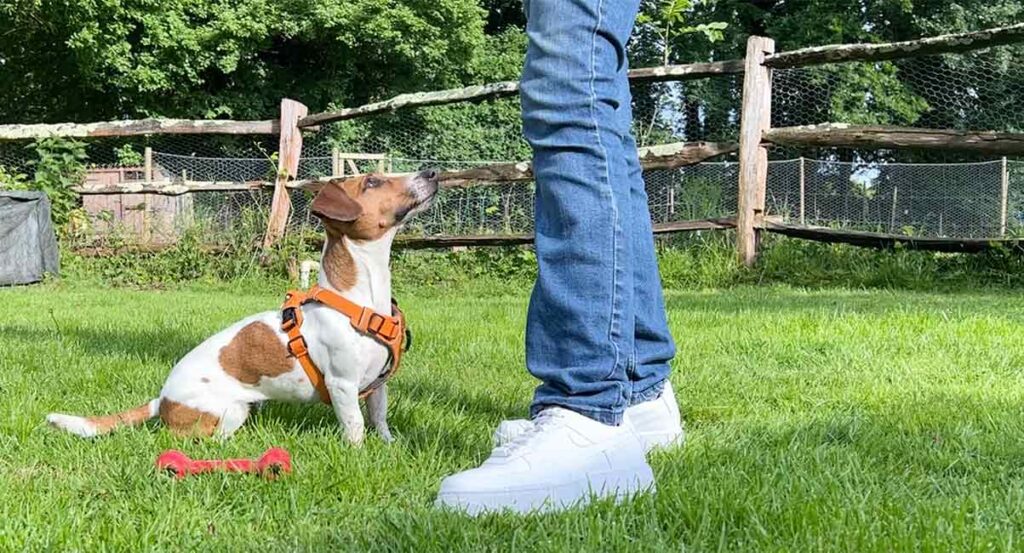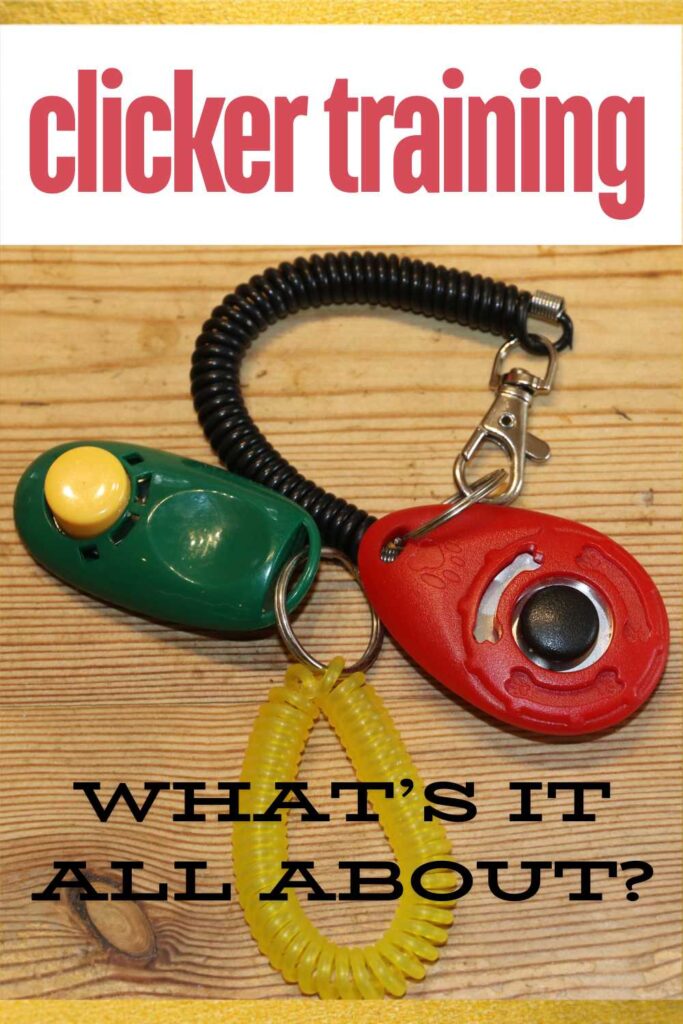We’ve come a long way since the early days of clicker training, when clickers were regarded as a new gimmick or passing craze by mainstream dog trainers, and thought unsuitable for ‘real’ training.

Now the tables have turned completely and most professional dogs trainers use clickers to some extent.
But what’s it all about?
Despite this, there are still many dog owners that aren’t quite sure what clicker training actually involves. Or even if it works. I know this because of the questions people ask me.
Questions like “Should I train with a clicker or a whistle”? And, “How will my dog hear the clicker when they are far away”
If that doesn’t strike you as ‘odd’ read on. All will be explained! Let’s first take a look at the clicker itself.
What is a clicker?
The original clickers were simple rectangular plastic boxes with a metal plate in the top.
Small enough to fit neatly in one hand, the metal plate makes a clicking noise when pressed. In fact it makes two rapid clicks. One on the way down, and one on the way up.
Which kind of clicker?
I still use these basic box clickers – they are extremely cheap, never seem to wear out, and are easy to use.
Of course, like anything else that becomes popular, you can now get clickers in all different kinds of styles.

Adjustable clickers (the sound can be softened) brightly colored clickers, clickers with wristbands attached (I like these), aerodynamic clickers. And so on!
Why the sound is important
The click from a clicker is a very distinctive sound. Not like anything else you are likely to hear in the home or out and about with your dog.
This is a good thing because it means the dog is always able to immediately identify the sound as being from your clicker. Once you have associated the sound of the clicker with food, it takes on a whole new and important meaning for your dog. I’ll look more closely at that in a minute.
Most dogs are not bothered by the sound of the clicker, but some may find it rather loud. This is where your adjustable clicker comes in. (Or you can mute the sound on a standard clicker with some tape)
What is a clicker for?
This is where I explain why the question above “should I train with a whistle or a clicker” is odd.
It’s a bit like saying – should I write with a pen or some paper?
You’re going to need both.
Whistles and clickers are both signals, but they have different roles in dog training. A whistle is a cue – it tells the dog to give a response of some kind. A clicker is not a cue at all, it is an event marker. It tells the dog we liked what he just did.
So when you train a dog to sit to a blast of your whistle, you give the whistle (the cue), the dog sits (the response), you click (the event marker) and reward the dog (the reinforcement)
Here is your trained response sequence
- Cue
- Response
- Mark
- Reinforce
Reinforcement is simply anything that makes your dog more likely to repeat his response again in the future. This will often be food, but it can be another kind of reward.
And we don’t need to worry about whether dogs can hear clickers at a distance because we don’t use them as cues. That’s the job of your whistle. We also mainly use clickers to establish new behaviors, not for controlling dogs outdoors.
How does the clicker work?
So, if a clicker tells the dog he did something right, how does that work? How does the dog know that the clicker means “YES! You did it”?
The clicker, or any other event marker, only works because it makes the dog feel good.
When he hears the click, he feels great and wants to feel that way again. In this way, the click reinforces (makes him want to repeat it) the dog’s behavior. And it only does this, because we build an association between the clicker and a great reward.
So the clicker actually does two things at once
- It marks events
- It predicts rewards
The clicker isn’t just an event marker. It is also a reward predictor. And it is this second attribute, the prediction of a reward, that gives the clicker its power.
Building the power of the event marker
To make your clicker powerful, so that it gives the dog a ‘buzz’ when he hears it, is an incredibly simply process
It simply involves pressing the click and following the click immediately with something the dog really likes.
This can be food, a game, or an opportunity to do something he really enjoys.
Once you have done this a few times, the association between click and treat is established. We call this ‘charging the clicker’ and it is all that is required to make the clicker a powerful reinforcer of behavior.
Keeping your clicker charged
Be careful though. The power of the clicker is quickly acquired and just as quickly lost.
If you stop following the click with food, the click will soon stop reinforcing your dog’s behavior. This is because the clicker is simply a temporary ‘stand in’ for the real reinforcer, which is the food that follows it.
Whilst I also use toys and games as reinforcement, and you can too, food is often the most efficient reward simply because it is so quick to deliver and receive. The dog can swallow a tiny piece of food in a second. Whereas it takes time to play a game.
Are there alternatives to the clicker?
Clickers are not the only event marker. You can use any kind of signal you like. Some people like to use a verbal event marker. I sometimes use the word YES when I want both my hands free. You could also use GOOD. Either is fine.
But bear in mind that the precise and unique sound of the clicker is a valuable thing. And it is hard to replicate those qualities with the human voice.
So is clicker training just ‘training with a clicker’?
This is where some people disagree. Some people believe that clicker training is just training with an event marker. And are quite happy to use punishment as well as reinforcement in dog training.
However, the majority of clicker trainers see clicker training as much more than just ‘training with a clicker’. They see it as a philosophy, and implicit in that philosophy is the rejection of any kind of punishment or ‘correction’.
Whatever your own ethical stance, there are actually some very sound practical reasons for the rejection of punishment in dog training- you can read about them here – the downside to punishing dogs.
What clicker training has done, is made training without punishment possible. Training methods probably weren’t accurate or effective enough to succeed without force until the need for event markers was identified.
Why clicker train?
So, what are the benefits of clicker training? And why should you give it a go?
Clicker training is all about training with positive reinforcement, and avoiding aversives. Positive reinforcement training is usually force-free and therefore stress-free for the dog. This speeds up the learning process and allows us to start training puppies at a far younger age than was previously possible.
It is much quicker to establish new behaviors, with clicker training than with old fashioned manipulative techniques, and very difficult to create complex chains of behavior without the clicker.
Making the change
You don’t have to abandon all aversives in training to make a start with clicker training, but you definitely should not try to correct a dog during a clicker training session.
If you enjoy clicker training and want to progress, you will probably find yourself abandoning corrections as a part of that process. This was how I got started with force-free training.
Clicker training involves the dog figuring out for himself what to do next and offering new and different ways to behave in the process. A dog that is regularly punished is unlikely to make much progress as he will be very wary of offering new behaviors.
Clicker training has a way of capturing the hearts of those who give it a go, and converting them to a new and better way of communicating with dogs. Many people find clicker training very calming and enjoyable, and in stark contrast to the ‘battleground’ training sessions that they previously endured.
Once you have picked up a clicker a few times you may find yourself, like many of those who ‘give it a go’, changing your whole approach to dog training.
A click is a promise
Remember, the click you make with your clicker is a promise to your dog, an IOU.
It tells the dog you owe him, and that he’ll get a reward very soon.
Clicker training itself holds a promise too. When you pick up that clicker, you are telling your dog that the game has begun. And implicit in that game lies the promise that there will be no ‘punishment’.
It is best not to break that promise
However you choose to train, there is no doubt that the use of an event marker will benefit your dog. And that the clicker is simply the best event marker that has yet been identified.
To really benefit from clicker training though, it helps to immerse yourself in the philosophy so important to many successful clicker trainers. The philosophy of training without force.
To do this, you’ll need to clicker train, and not just ‘train with a clicker’.
The clicker is a very powerful tool, providing you keep your side of the bargain. I think you’ll love it.
How about you?
Are you already clicker training? Tell us what you like best about it. Share your thoughts in the comments box below

Free Training Tips
Get Pippa's free dog training tips delivered to your inbox

 Choosing Treats For Raw Fed Dogs
Choosing Treats For Raw Fed Dogs